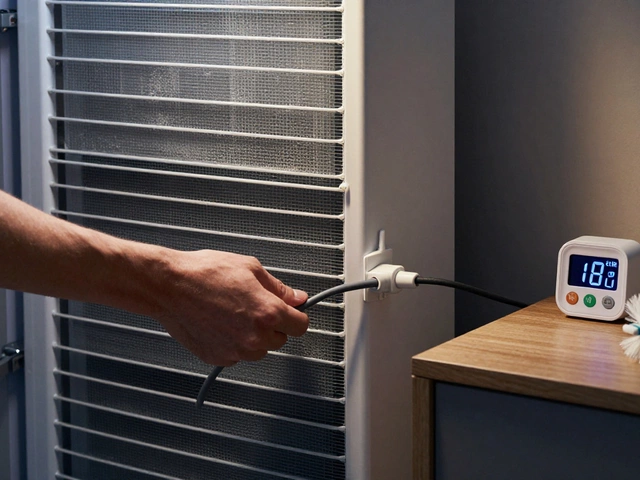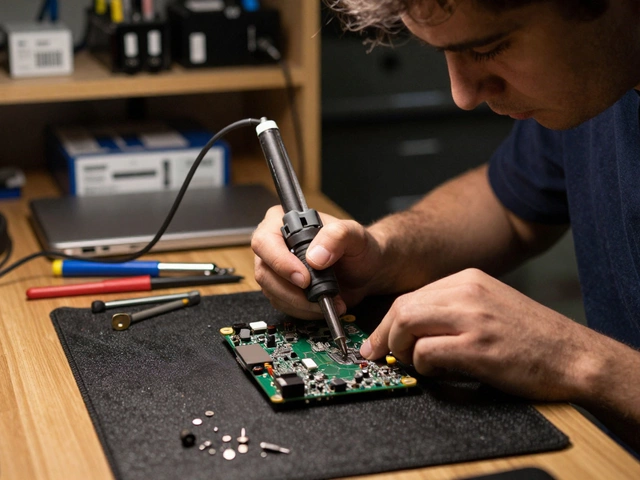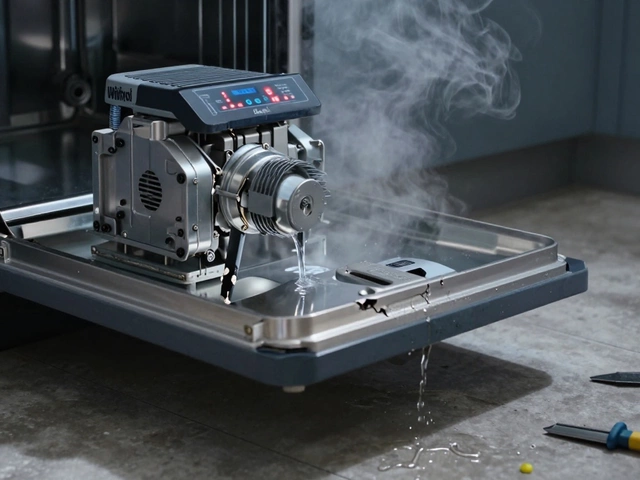If your electric oven suddenly stopped working, you’re not alone. It’s one of the most common appliance emergencies - especially in Vancouver winters when you rely on it to bake cookies, roast chicken, or just keep the kitchen warm. One minute it’s heating perfectly, the next it’s dead silent, no light, no fan, no heat. No warning. No error code. Just silence. And now you’re staring at a cold oven wondering what went wrong.
Is it the power supply?
Before you call a repair tech, check the simplest thing first: power. Electric ovens need 240 volts to run. That means they’re connected to a double-pole circuit breaker, not a regular 120-volt one. If that breaker tripped, your oven won’t work - not even the light or display. Go to your electrical panel. Look for a breaker that’s halfway between on and off. It might look normal, but if it’s tripped, it won’t be fully snapped into place. Flip it all the way off, then back on. If it trips again right away, there’s a short circuit or overload. Don’t keep resetting it. That’s dangerous.
Some older homes have fuses instead of breakers. If you have a fuse box, check the two fuses that feed your oven. If one is blown, the oven won’t heat - even if the light still works. Replacing a fuse is easy, but only if you know what you’re doing. If you’re unsure, call an electrician. Working with 240 volts isn’t something to guess at.
What if the oven light works but it won’t heat?
This is a classic sign of a broken heating element. Your oven has at least two: one on the bottom for baking, and one on the top for broiling. If the bottom element burned out, you’ll still see the light, the fan might run, and the display works - but no heat comes out. Look inside the oven. Is the element blackened? Cracked? Has it separated in the middle? If so, it’s dead. These elements don’t last forever. Most last 5 to 10 years, depending on how often you use them and how clean the oven is.
Replacing a bake element is one of the easiest oven repairs you can do yourself. Turn off the power at the breaker. Remove the two screws holding the element in place. Pull it out slightly - the wires will still be attached. Unplug the wires and plug them into the new element. Slide it back in. Tighten the screws. Turn the power back on. Done. You can buy a replacement element for $30-$60 from appliance parts stores or online. Make sure you match the model number exactly.
Could the thermostat or temperature sensor be the issue?
Yes. If your oven heats unevenly, runs too hot, or shuts off before reaching the set temperature, the thermostat or temperature sensor might be faulty. Modern ovens use a temperature sensor - a thin metal probe that sticks into the oven cavity. It tells the control board how hot it is inside. If that sensor is damaged or coated in grease, it gives wrong readings. The oven thinks it’s hot enough, so it shuts off early. Or it keeps heating past the set point.
To test it, you need a multimeter. Set it to measure resistance (ohms). Disconnect the sensor wires. Touch the meter probes to the two terminals. At room temperature, it should read around 1,000-1,100 ohms. If it reads zero or infinity, the sensor is dead. Replacing it costs about $40-$70. It’s located on the back wall of the oven, usually near the top. Remove the screws, unplug, swap it out. Easy fix.

Is the control board failing?
The control board is the brain of your oven. It tells the heating elements when to turn on and off. If it’s damaged - by power surges, moisture, or just age - the oven won’t respond at all. Signs include: no display, unresponsive buttons, or the oven turning on randomly. Control boards fail more often in homes with old wiring or no surge protector.
Replacing a control board is trickier. It costs $150-$300, and you need to match the exact part number. Some models have a fuse on the board that can be replaced for under $10. If you’re comfortable with electronics, you can open the control panel (after turning off power) and look for a small glass fuse. If it’s blown, replace it. If the board itself is fried, you’ll need a new one. But here’s the catch: if you replace the control board without fixing the root cause - like a bad element or shorted wiring - the new board will die too.
What about the oven door switch?
Many ovens have a safety switch that cuts power when the door is open. If that switch gets stuck or fails, the oven won’t heat - even with the door closed. You might hear a faint click when you close the door. If you don’t, the switch might be broken. To test it, open the door and look for a small plastic or metal tab that depresses when the door shuts. Push it manually with a pencil. If the oven light turns off, the switch is working. If not, it’s bad. Replacement switches cost $15-$25. You’ll need to remove the oven’s outer panel to access it.
Could a power surge have killed it?
Yes. Vancouver has occasional voltage spikes from storms, grid switching, or even neighbors running heavy equipment. If your oven died right after a thunderstorm or a power flicker, a surge likely damaged the control board or electronic components. If you have other appliances acting weird - lights dimming, microwave resetting - you’re probably dealing with a larger electrical issue. Consider installing a whole-house surge protector. They cost $300-$500 installed, but they can save you hundreds in appliance repairs over time.

When should you call a professional?
You should call a technician if:
- The circuit breaker keeps tripping after resetting
- You smell burning plastic or see smoke coming from the oven
- You’re not comfortable working with electricity or internal components
- You’ve replaced the element and sensor, and it still doesn’t work
Professional oven repair in Vancouver typically costs $100-$200 for a service call, plus parts. Most reputable techs will give you a free estimate. If the repair quote is over half the price of a new oven, it’s usually smarter to replace it. New electric ovens with smart features and better efficiency start around $700.
How to prevent this from happening again
Regular maintenance keeps your oven running longer:
- Clean the oven every 3-6 months. Built-up grease can cause overheating and damage sensors.
- Don’t use aerosol cleaners inside the oven. They can corrode wiring and electronics.
- Check your circuit breaker panel once a year. Look for loose wires or corrosion.
- Use a surge protector for major appliances. Plug your oven into a dedicated 240-volt surge protector if available.
- Replace worn door seals. A leaky door makes the oven work harder and shortens component life.
Most electric ovens last 13-15 years. If yours is older than 10 and you’re fixing it for the third time, think about upgrading. Newer models are more energy-efficient, have better temperature control, and come with self-cleaning features that reduce wear on internal parts.
What to do right now
Here’s your quick checklist if your oven died today:
- Check the circuit breaker - flip it off and back on.
- Look at the bake element - is it cracked or blackened?
- Test the temperature sensor with a multimeter if you have one.
- Listen for a click when closing the door - that’s the safety switch.
- If none of that works, and you’re not comfortable digging deeper, call a licensed appliance technician.
Don’t ignore a dead oven. It’s not just an inconvenience - it’s a safety risk if the problem is electrical. Take the time to diagnose it properly. You might save yourself $500 on a new oven… or avoid a fire.
Why is my electric oven completely dead with no display?
If the display is blank and nothing turns on, the most likely cause is a tripped 240-volt circuit breaker or a blown fuse in the panel. It could also be a failed control board or a broken power cord connection inside the oven. Start by checking the breaker. If that’s fine, you’ll need to open the back panel and test for power at the terminal block. If no power is reaching the board, the issue is upstream - either the house wiring or the outlet. If power is there but the board still doesn’t light up, the board itself is dead.
Can a dirty oven cause it to stop working?
Yes. Heavy grease and food buildup can insulate the temperature sensor, making it read lower than the actual oven temperature. This tricks the control board into thinking the oven isn’t hot enough, so it keeps the heating element on longer - which can overheat and burn out the element or damage the sensor. In extreme cases, grease can drip onto wiring and cause shorts. Cleaning your oven regularly isn’t just about hygiene - it’s a key part of preventing breakdowns.
Is it safe to use the stove top if the oven doesn’t work?
Yes. The stove top and oven usually have separate circuits and controls. Even if your oven is completely dead, the burners should still work fine. That’s because the stove top runs on 120 volts for the elements and controls, while the oven uses 240 volts. A failure in the oven circuit won’t affect the cooktop unless there’s a major wiring fault - which is rare.
How long does it take to replace a heating element?
With the right tools and a little patience, replacing a bake or broil element takes 20 to 30 minutes. You’ll need a screwdriver and possibly a wrench to remove the mounting screws. The hardest part is often getting to the element - some ovens require removing the back panel or the oven floor. Once you have access, unplugging the old one and plugging in the new one is straightforward. Just make sure the power is off before you start.
Should I repair my 15-year-old oven or replace it?
If your oven is 15 years old and you’re replacing a major component like the control board or heating element, replacement is usually the smarter choice. Older ovens are less energy-efficient and lack modern safety features. A new oven will use 20-30% less electricity and often includes better temperature accuracy and self-cleaning modes. Plus, warranties on new ovens typically cover parts for a year. Repairing a 15-year-old oven is like patching an old tire - it might work for a while, but the rest of the system is wearing out.




